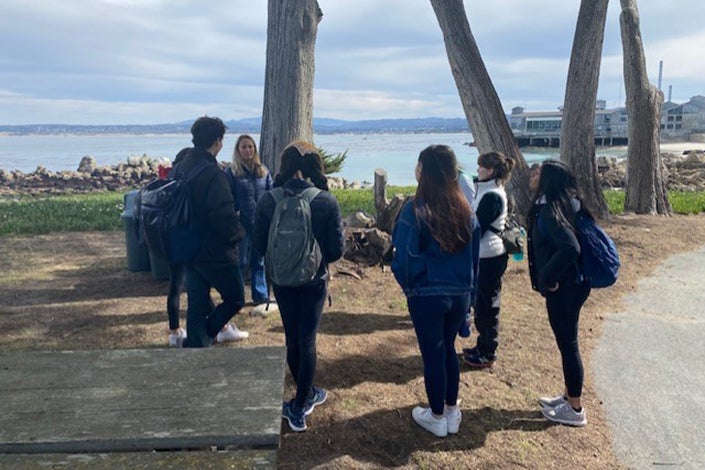On an overnight trip to Stanford University’s Hopkins Marine Station in Pacific Grove, students in the course The Artful Interpreter find themselves in a place famous for art, science, and the intersection of the two. That outing has all the elements a student might expect of a Monterey-Bay-adjacent retreat – whale watching, tidepooling, building bonds with classmates, and taking a break from campus life. It’s also instructor Sara Michas-Martin’s ingenious way of creating a special atmosphere conducive to a science-themed creative writing workshop.

Stanford marine ecologist Fiorenza Micheli giving the Artful Interpreter class a tour of the Hopkins campus. (Image credit: Sara Michas-Martin)
“There’s a removal of competitive boundaries when we’re sitting outside and discussing disappearing kelp forests or genetically modified organisms. People are freely sharing their ideas in a way that doesn’t happen when you’re around a table with a buzzing light and a whiteboard,” said Michas-Martin, who is a lecturer in creative writing in the School of Humanities and Sciences.
The course’s core of trust and open interdisciplinary exchange is foundational to what Michas-Martin sees as an important overlap between art and science, both of which “seek to understand through process,” she said. Students learn literary techniques that emphasize creating an experience for a reader that moves beyond disseminating information or thesis-based writing, one that explores the possibilities of communicating science and human experience simultaneously.
Inspiration at Hopkins
After moving near Monterey, Michas-Martin learned she could use the Harold A. Miller Marine Biology Library at Hopkins. She was welcomed by librarians and introduced shortly thereafter to Stuart Thompson, a biologist who invited her to guest lecture in his sophomore college course BIO 10SC: Natural History, Marine Biology, and Research. Michas-Martin then approached Mark Denny, director of Hopkins at the time, about a collaboration between Hopkins and the Creative Writing Program.
“In these turbulent times, scientists struggle to convey to the public the importance of scientific research and the trust that science and society need to share,” said Denny, who is the John B. and Jean De Nault Professor of Marine Science in the School of Humanities and Sciences. “Sara’s course in creative nonfiction was designed to instill in Stanford undergrads the love of writing about science, and the skills to do it properly. We couldn’t think of a better context in which to do that than visits to Hopkins and Monterey Bay.”
In addition to allowing for experiential learning, the vision for the collaboration provided students the chance to experience the Pacific Grove campus and learn about research opportunities from the Hopkins biologists. “From seeing whales offshore to getting wet and cold messing about in tide pools, the Hopkins experience has a way of inspiring folks,” said Denny, who has heard many positive accounts of the course from students, many of whom have gone on to apply for spring quarter in residence at Hopkins.
A true workshop
Throughout the course, students read published essays by physicians, naturalists, cancer survivors, biologists, and journalists. True to a traditional workshop, the core of the course is group discussion of pieces written by members of the course.

Students in the 2020 session of Artful Interpreter walking along the coast of Monterey Bay. (Image credit: Sara Michas-Martin)
In their writings, the students experiment with how to engage, immerse, and inform readers, blending their passion for science with nonfiction creative writing and personal narrative. Topics span the range of sciences and human experience, combining computer science and awkward roommate interactions, travel and physics, and plant biology and sibling competition.
“One of the most rewarding aspects of teaching this class is watching students break from a singular way of seeing when given the chance to apply creative expression to a scientific problem they are passionate about,” said Michas-Martin.
“I had not anticipated the profound emotional and philosophical aspects of the pieces that we both read and wrote in class, but accessing the human experience as we explored more scientific or technical information ended up being what drove my interests and writing throughout the class,” said Emilie Kono, a co-term student in bioengineering, who took the class in winter quarter. “My focus shifted from just simply writing from a standpoint of achieving practicality, to attempting to capture beauty that I could share with the reader and finding overlap between science and art.”
The workshop’s structure, the members’ shared interest in science and art, and the field trips all combined to help create lasting relationships.
“It was so valuable to have people around me who are interested in the same overlap between science and creative writing,” said Aspen Stuart-Cunningham, ’24, an undergraduate physics student. “It is hard to find spaces for exactly what I want to do and to find people that I see myself in at Stanford, and so I was very grateful to find other people like that and be so inspired by my peers throughout this class.”
To read all stories about Stanford science, subscribe to the biweekly Stanford Science Digest.
Media Contacts
Taylor Kubota, Stanford News Service: (650) 724-7707; tkubota@stanford.edu